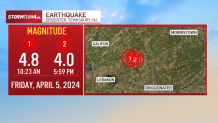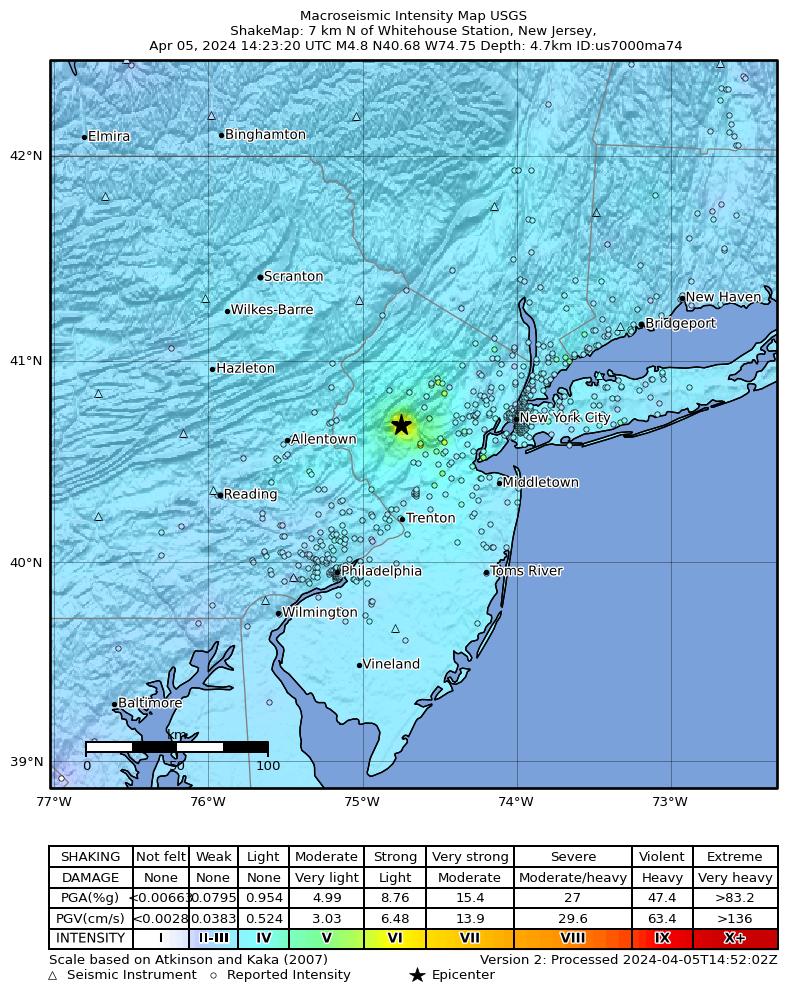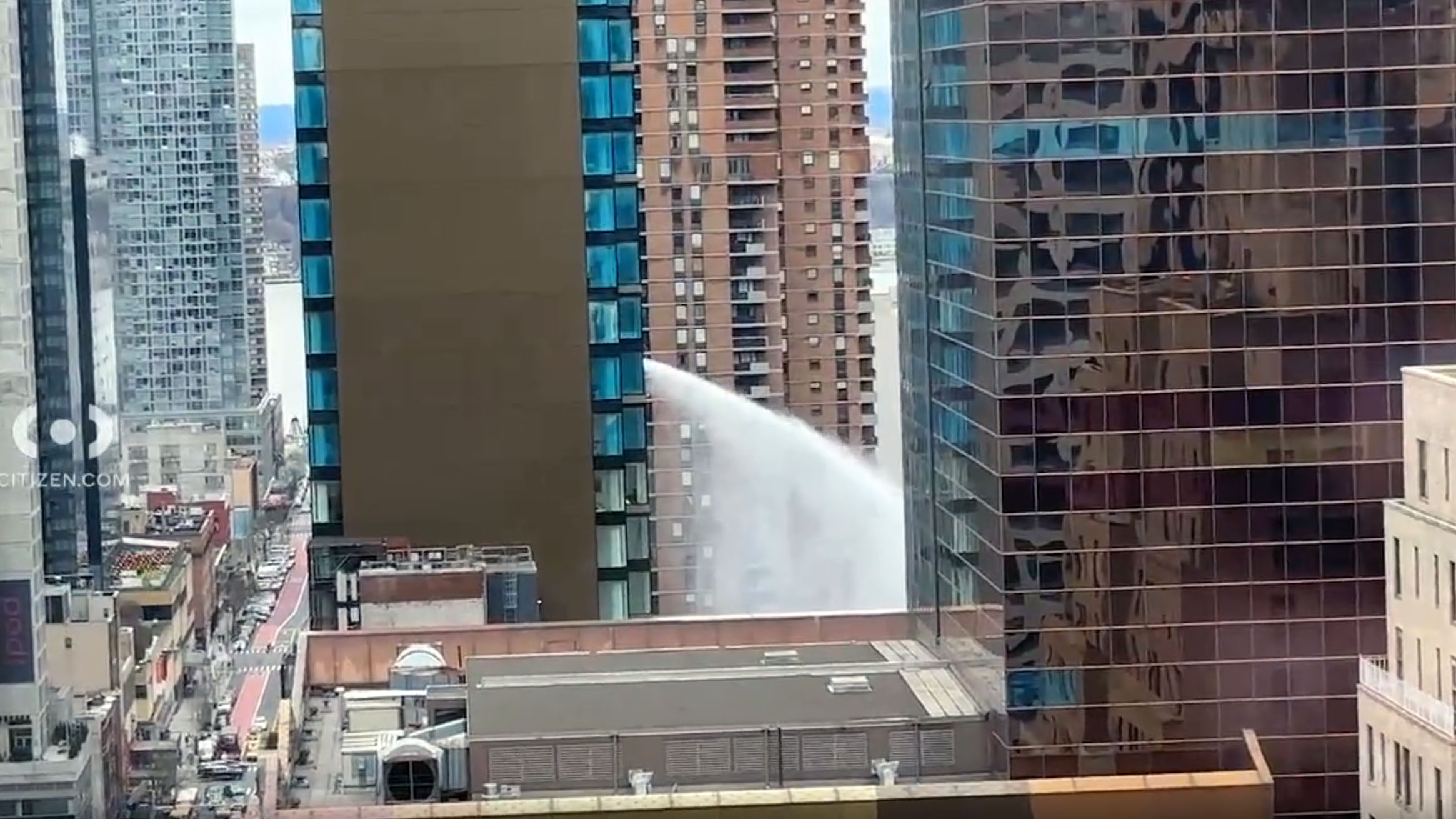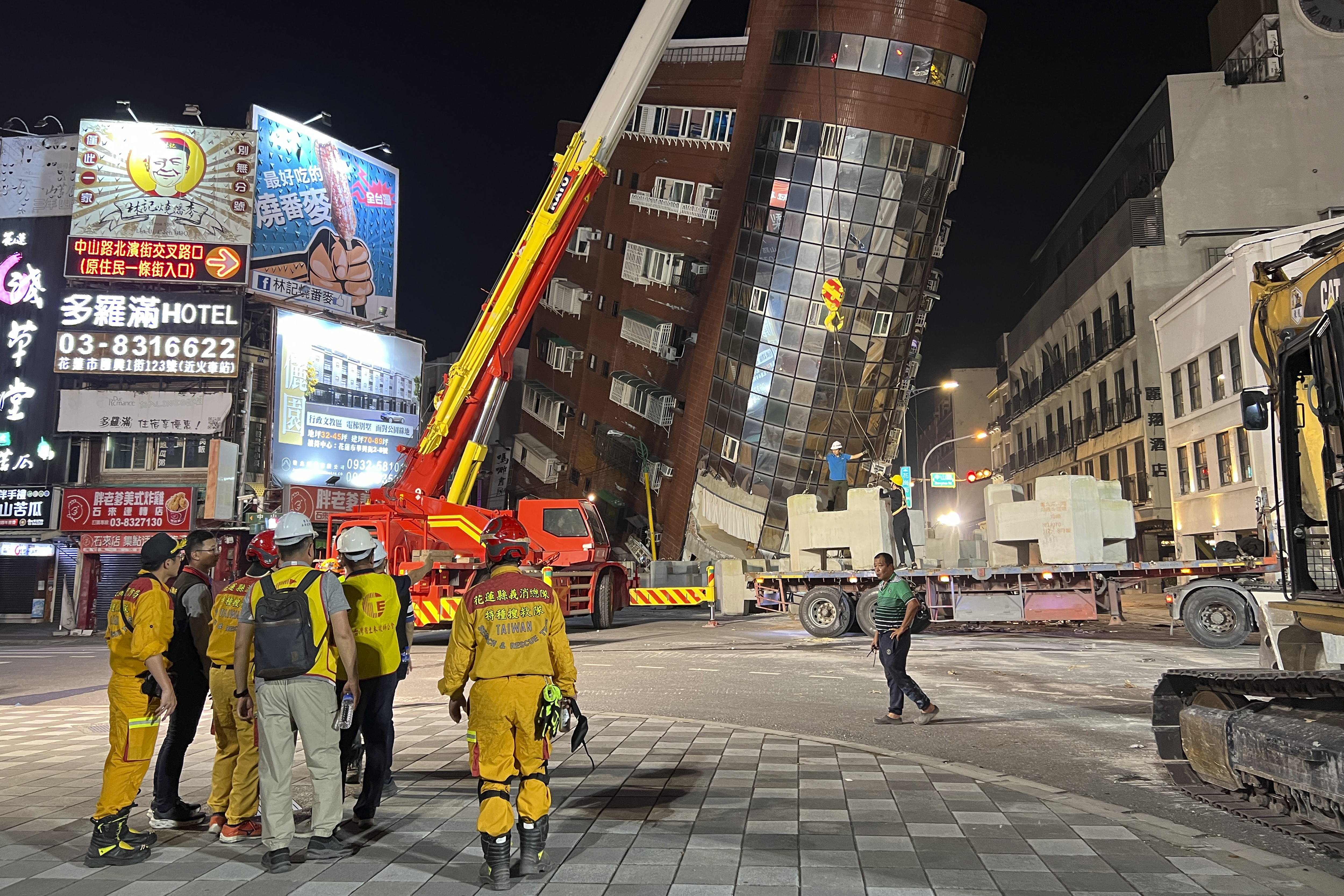What to Know
- A magnitude 4.8 earthquake hit Hunterdon County, New Jersey, at 10:23 a.m. Friday -- and it reverberated across the entire tri-state area; there have been no reports of damaged buildings
- No injuries were reported; no earthquake of that magnitude has had an epicenter near NYC since 1884, according to the U.S. Geological Survey
- Hours later, a magnitude 4.0 aftershock hit the same area of New Jersey just before 6 p.m., according to the USGS. Further aftershocks will be unpredictable but are possible for the next week, experts say; if you find yourself in one, drop to the floor and cover your neck
A magnitude 4.8 earthquake struck New Jersey Friday, triggering frenzied phone calls from Manhattan to Albany to Long Island, Montclair and New Haven, as buildings rumbled in a region unaccustomed to the ground shaking — and that was before the area was hit with an aftershock almost as powerful.
The U.S. Geological Survey said the inital quake hit just over four miles north of Whitehouse Station, just below Tewksbury in Hunterdon County, about 40 miles west of New York City, at 10:23 a.m. It was a shallow earthquake, only 2.9 miles deep, which means an earthquake of that strength would be felt by a larger number of people. USGS put that number at 42 million.
"We're taking this extremely seriously," New York Gov. Kathy Hochul said, calling it the most powerful earthquake felt by the East Coast since at least 2011 and the strongest to hit the East Coast directly in the last century.
Perhaps most surprising: No injuries or any significant building damages were reported throughout the entire region.
Get Tri-state area news delivered to your inbox. Sign up for NBC New York's News Headlines newsletter.
For context, a magnitude 4.0 quake can be felt about 60 miles from the epicenter; a magnitude 5.5 quake can be felt from 300 miles from the center. This 4.8 one reverberated throughout the entire tri-state, and was felt as far away as Maryland and Maine, according to witness reports.
USGS reported "moderate" intensity near the epicenter, with light and weak shaking reported regionally.
Hours later, a magnitude 4.0 aftershock hit the same area of New Jersey just before 6 p.m., according to the USGS. The epicenter of the aftershock was said to be 7.4 miles northwest of Bridgewater, which is just over the county line in Somerset County. The aftershock was significantly deeper than the initial quake, about 5.6 miles deep, which explains why it wouldn't have been felt by as many people.

A much smaller aftershock, magnitude 2.0, was reported by the USGS in Bedminster, New Jersey, around 11:20 a.m. It was one of 12 aftershocks since the initial quake that have registered at least 1.8 or higher on the Richter scale, according to USGS geophysicist Timothy Clements. There may have been more, but any below 1.8 in magnitude would have been undetected.
Further aftershocks will be unpredictable but are possible for the next week, experts say. The USGS said there would be nearly a 50% probability of an aftershock magnitude 3.0 or more, a 16% of one magnitude 4.0 or more, and even a 3% chance of one that was more intense than the initial quake. If you find yourself in an aftershock, experts say you should drop to the floor and cover your neck.

Hochul said she directed her team to conduct damage assessments, including checking all state roads as well as major transmission lines and dams. The Democrat encouraged all municipalities to send crews for structural integrity assessments and vulnerable locations.
In New Jersey, there were few reports of damage, despite the epicenter being located there. There were three homes in along Seventh Avenue in Newark that saw structural damage after their roofs appeared to have collided during the shaking. Ten families, including 25 adults and three children, were relocated as a result.
Pictures and decorative plates tumbled off the wall in Christiann Thompson's house near Whitehouse Station, she said, relaying what her husband had told her by phone as she volunteered at a library.
“The dogs lost their minds and got very terrified and ran around," she said.
Whitehouse Station Fire Chief Tim Apgar said no injuries were reported, but responders fielded some calls from people who smelled gas. Nearby, the upper portion of the 264-year-old Col. John Taylor’s Grist Mill historic site collapsed onto a roadway, according to Readington Township Mayor Adam Mueller.
In New York City, people described feeling the quake as a slight vibration. Some thought it was just a subway rolling underground beneath them or construction nearby; others didn't feel it at all. A meeting at the United Nations was briefly disrupted. Hour-long ground stops were ordered at JFK and Newark airports to allow crews time to ensure the quake didn't cause any runway cracks, but no damage was found and those stops were lifted.
Traffic through the Holland Tunnel between Jersey City and lower Manhattan was stopped for about 10 minutes for inspections, the Port Authority of New York and Jersey said.
In midtown Manhattan, motorists blared their horns on shuddering streets. Some Brooklyn residents heard a boom and felt their building shaking. Cellphone circuits were overloaded for a time as people tried to reach loved ones. Later, phones blared with earthquake-related notifications during the New York Philharmonic’s morning performance, where Anton Webern’s Six Pieces for Orchestra “literally ended with a cellphone alert,” said spokesperson Adam Crane.
The Department of Education sent messages to guardians of New York City Public School students ensuring them that their kids' were safest inside their classrooms, and that dismissal proceeded as usual later in the day.
The NYPD says all relevant emergency agencies were briefed on the situation, though impacts were minimal. Mayor Eric Adams said there were no reported safety or infrastructure problems, nor any disruptions to the power, water or gas system.
The mayor also said the Department of Buildings found no problems after conducting inspections, though the DOB will continue to look at all buildings in the coming days for any delayed cracks or other effects on the city's 1.1 million buildings. The department had not received any calls about structural concerns.
Engineers said New York’s skyscrapers are made of high-strength materials and designed to sway slowly to withstand winds and other impacts. Modern high rises also have other features to help absorb any shock.
“High-rise buildings can be one of the safest places you can be in an earthquake,” said Ahmad Rahimian of the engineering firm WSP Global.
The MTA said service was not impacted, though teams were dispatched to inspect train lines and tunnels. New Jersey Transit reported up to 20-minute delays due to crew bridge inspections in the aftermath, but service was not impacted further.
There were no reported issues along the infrastructure for MTA, after both the initial quake and the powerful aftershock hours later, saying that the system continued to run "safely and normally."
History of earthquakes in Tri-State
Earthquakes with magnitudes near or above 5 struck near New York City in 1737, 1783 and 1884, the USGS said. Take a look at a list of the most powerful earthquakes near NYC in history.
The most powerful quakes near the city were on Aug. 10, 1884, and Dec. 19, 1737, according to the Lamont-Doherty Cooperative Seismographic Network. Both of those quakes were magnitude 5.2 in the greater NYC area, but the exact spot where they occurred is not known.
Friday's quake stirred memories of the Aug. 23, 2011, earthquake that jolted tens of millions of people from Georgia to Canada. With an epicenter in Virginia, it left cracks in the Washington Monument and rattled New Yorkers ahead of the 10th anniversary of the Sept. 11 terror attacks.
It's not the first quake to rumble the tri-state area this year. In January, a magnitude 1.7 earthquake struck near Astoria, Queens, according to USGS.
Earthquakes in the New York City area are rare, even if they seem increasingly common in recent years.
There are fault lines in the city but experts say residents have nothing to fear.
“I wouldn’t worry about it too much. The East Coast has been geologically stable for millions of years," Stephen Holler, an associate professor of physics and engineering at Fordham University, said.
He did not expect aftershocks to be a concern.
While a relatively strong earthquake for this part of the United States, it doesn't compare to the one that hit Taiwan earlier this week. The country's strongest earthquake in more than 25 years, the magnitude 7.4 quake that hit Wednesday killed at least nine people died and hurt more than 1,000. Scores remain missing.
Earthquake felt across Northeast
In Astoria, Cassondra Kurtz was giving her 14-year-old Chihuahua, Chiki, a cocoa-butter rubdown for her dry skin. Kurtz was recording the moment on video, as an everyday memory of the dog’s older years, when her apartment started shaking hard enough that a 9-foot-tall mirror banged audibly against a wall.
Kurtz assumed at first it was a big truck going by. The video captured her looking around, perplexed. Chiki, however, “was completely unbothered.”
Attorney Finn Dusenbery was in a law office in midtown Manhattan. “The building shook and I thought that the ceiling above me was going to collapse,” Dusenbery said. “I did think that maybe the building was going to fall down for a second, and I wanted to get out of the building when I felt that.”
At a coffee shop in lower Manhattan, customers buzzed over the unexpected earthquake, which rattled dishware and shook the concrete counter. “I noticed the door trembling on its frame,” said India Hays, a barista. “I thought surely there couldn’t be an earthquake here.”
Solomon Byron was sitting on a park bench in Manhattan’s East Village when he felt an unfamiliar rumble. “I felt this vibration, and I was just like, where is that vibration coming from,” Byron said. “There’s no trains nowhere close by here or anything like that.” Byron said he didn’t realize there had been an earthquake until he got the alert on his cellphone.
People in Baltimore, Philadelphia, Connecticut and other areas of the Northeast reported shaking. Tremors lasting for several seconds were felt over 200 miles away near the Massachusetts-New Hampshire border.



